

CRB in Natural Areas
Introduction
In July 2024, the Priority Oʻahu Native Ecosystems (Priority ONE) working group hosted a virtual discussion to share questions and experiences regarding Coconut Rhinoceros Beetle (CRB) in natural areas on Oʻahu. CRB has been present on Oʻahu for over 10 years, and early in 2023, the NRM community saw the first signs of the beetle interacting with endangered loulu (Pritchardia spp). Also, in 2023, CRB was confirmed on Kauaʻi, Maui, and the Island of Hawaiʻi. These key events indicate a new phase in the CRB invasion in Hawaiʻi and shifted the conversation around CRB, including a Pritchardia working group--focused on endangered species management--and the release of a Statewide Communication Plan out of the CRB Response Team.
Priority ONE held this meeting to connect managers in the spaces between the statewide response and loulu specific management actions. The meeting had 36 participants, representing federal, state, and county programs as well as several private land management entities. We also had statewide invasive species management, including the CRB Response Team, HISC, and Pacific-RISCC, as well as several managers from other islands, join us. Each participant was given the opportunity to share their questions and concerns, with members from the audience providing their experiences and answering questions in response. The CRB Respons Team provided the bulk of the information shared below. The conversation was filled with information from both scientific investigations and from tacit knowledge gained through experience managing CRB in a variety of contexts (e.g., natural, urban, and agricultural)--which should be clearly indicated in the responses below.
Question topics included how to evaluate CRB habitat, stick pile management, CRB treatment options, distribution in natural areas, monitoring and funding. You can jump to the questions in each section with the buttons above, and with the slider menu on the left of the screen. Please note: this is still a resource in progress. Let us know if we can improve it in any way, whether you see a typo or have clarification suggestions.
Distribution
Are CRB breeding in mauka areas on Oʻahu?
How far can CRB fly from agricultural and urban areas to natural areas?
What is the highest elevation that CRB can successfully breed at? Is there a minimum or maximum rainfall they need to persist?
Various field crews are seeing them in mauka restoration sites in the Waiʻanae Mountains, and there have been confirmed Pritchardia CRB deaths in both the Waiʻanae and Koʻolau Mountains. However, it does not appear that there are any established populations in mauka areas of either mountain range yet.
They will fly as far as they need to reach food or breeding material. Thatʻs usually less than a mile but CRB can fly at least 2 miles if needed.
Will placing traps in natural areas increase the abundance of CRB and damage to vulnerable species?
How much CRB are we seeing in natural areas
See images below
CRB are a tropical species but the adults and larvae can persist in non-tropical temperatures. CRB can survive and devlop completely in breeding material that averages 70 degrees F but they donʻt thrive. Ideal breeding temperatures are around 80 degrees F. If temperatures are consistently below 70F, I think that host damage would be low and would scale with temperature.
CRB traps work over short distances so a trap may pull in beetles from a few hundred feet away but not a half mile. We prefer to place traps at least 100 feet from a host plant or breeding material for two reasons. One, the traps donʻt compete very well with alms and breedingmaterial and you will get low catch rates. Two, we donʻt want to attract beetles directly to their food source or breeding sites.
Trap Detections 2013-2018
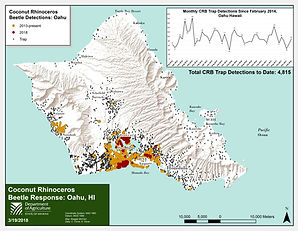
click to enlarge
Trap Detections 2019-2022

click to enlarge
Trap Detections 2024 ONLY
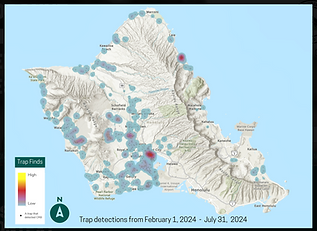
click to enlarge
Evaluating CRB Habitat
Is a decaying palm better breeding site than a slash pile?
Is decaying grass biomass a concern when considering CRB breeding sites?
In nature, standing palms are their primary breeding site so they definitely breed well in them. If you do have a tree that becomes a breeding site and you chip it, you're going to kill what's currently in them. It does depend on the timing– if you can catch it when there's a big population of bugs, and then you chip it, you're gonna kill some of them. It is currently unclear what is a better breeding site--a standing dead tree versus a pile of chipping. But they are both going to be breeding sites.
Are slash piles attractive to CRB? Is there a way to manage slash piles to minimize their attractiveness to CRB?
We have seen CRB breeding in grass material. The main test that we've done to confirm this is put CRB into a thatch and sand mixture and the larvae grew really well in that material. However, we have also surveyed piles of grass clipping and it seems like it's probably not their favorite material, just based on how frequently we find them in that kind of material--they prefer wood material. Definitely, they're attracted to, you know, decaying palm material, but almost any wood is good. I think that the grass would support their survival, but I'm guessing it's less attractive, so lower risk, but not zero risk. At this time, we don't have a good quantitative measure or any more specific experiments than that.
Does the moisture in a grass pile influence if it's good breeding habitat or not?
In general, chipping material and leaving it in a pile is going to create better habitat for CRB than leaving material whole If possible, it's probably better to lay slash material whole in a pile, and even stack it on top of itself. The less stuff that's touching the ground, the slower it's going to decay, and the lower populations it's going to support per month.
Is there some sort of indicator that a slash pile may be infested with CRB? For example, an odor or visual que?
CRB need a minimum amount of moisture, especially for the very young larvae. The bigger they get, the more resistant they are to at least periodic desiccation. The material, whether it's wood or whatever plant waste material you're dealing with, it's got to be at least periodically moist. If it's constantly bone dry, they won't be able to establish in that material. That's part of the stacking--if material doesn't stay moist for very long, it's going to decay less quickly, and it's not going to support the CRB. Anything you can do to dry out that material and slow down its decay will impact survival and potential establishment. Especially in dry areas, if you've got waste, and you can spread it more thinly, even if it does rain it's going to dry out pretty quickly.
When we go into a forest, and there's two inches of decaying matter across an entire site, and then we make a big slash pile, how worthwhile is it going to be to net that slash pile? Will CRB persist in leaf litter on the forest floor, or only in rotting woody material?
There's definitely not an odor that humans can smell. Even our dogs have trouble with an undisturbed pile. One of the problems is the beetles like to be inside of material. So if it's a log, they'll be inside the decaying logs. When we survey we usually look for a larva or frass, the larval poop. The adult poop is just liquid and you usually don't see it anywhere. However, the larval poop looks a lot like rat droppings so it can be hard to distinguish that. If you see something that looks like rat droppings, but it's inside of a log, that would be a good sign that CRB is in that pile. But there's not a really easy way to casually, as you're walking by, notice that CRB are in the pile.
There is not a lot of good data on the relative attractiveness of a bunch of leaf litter, compared to unchipped material and chipped material. But in general, chipped and nicely decaying compost and mulch is very attractive. Decaying palm logs are very attractive. Slowly decaying material is less attractive. Non-wood material is less attractive. Leaf litter is is probably on a lower tier than a big slash pile, especially if you're accumulating altogether–however we don't have hard numbers on that.
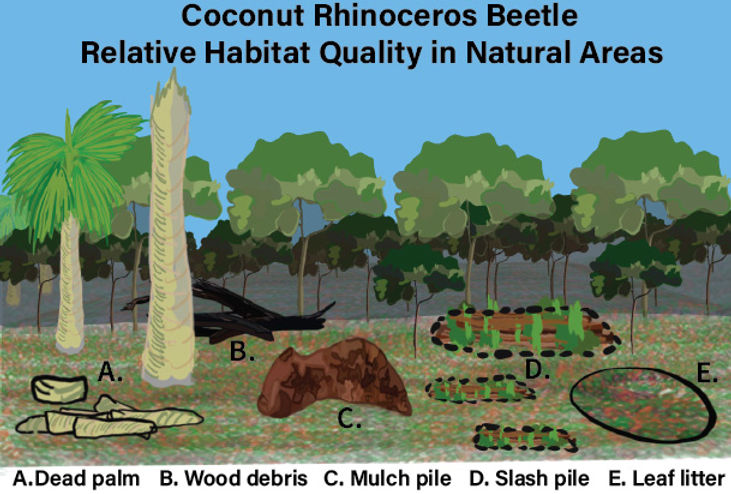
A. In nature, dead standing palms are the primary breeding habitat for Coconut Rhinoceros Beetle (CRB). As such, palm logs are also ideal breeding material.
B. Palm debris is closely followed by woody debris of any species.
C. Chipping creates really great habitat for CRB and can they can usually support higher numbers in a mulch pile compared to a pile of whole materials. Avoid chipping if possible and if you do chip material, ideally spread it out so that it is barely covering the ground. Wood chips dispersed in that way is not going to be an accumulation of material that CRB likes. The worst case scenario is to put chips in a big pile.
D. Live wood is less attractive to CRB than decaying woody debris, as well as slowly decaying material. Stacking your slash piles to control its decomposition rate can keep it less attractive to CRB. The more material on the ground, the faster the decomposition rate, so piles with a smaller footprint will decompose slower. Shorter piles will dry out faster than taller, deeper piles which also acts to slow down decomposition.
E. Non-wood material is less attractive to CRB than woody material, therefore leaf litter is probably less desirable than a big slash pile.
Stick Pile Management
How can I make my slash piles more manageable? Is there an appropriate size for them? Is there a better kind of spacing system throughout my restoration site? Is it better to make many small piles all over the place, or concentrate all your slash in one giant pile?
I think that having slower decay is better. If material is on the ground, it's decay is usually faster. If you can stack stuff up a bit so that the top material is drier, and doesn't decay as quickly then that's going to support fewer CRB per month. Of course, if that giant pile gets big enough, then there's going to be some spots in the middle that are more moist. Maybe sort of a medium stacked pile that is longer could be good. I'm just kind of thinking out loud. But really, having nice decaying material is what they like, so anything you can do to delay, or reduce the amount of decaying material at any point is good.
Does creating slash piles to have slower decay just create a situation where in the future you are going to have good CRB breeding habitat?
A lot of that depends on what's happening in the site. If you're regularly removing material every month, if it's slow to decay, you're going to build more and more and more material, so eventually, you're going to end up with the same burden of decaying material. If it's more like a one or two time thing, and you can make it decay more slowly, that's going to be better for your palm health, because there's going to be fewer CRB at any one moment. Chipping and leaving it in a pile, that's going to be giving you the biggest burst of CRB, in the short term. If material is abundant and decaying slowly over time, you're gonna have longer sustained populations in the area. Another thing to take into account is how much other good breeding material is in the area? And how big of an effect are you going to have? If you're working on a restoration site, and there's giant mulch piles like 500 feet away, what you do is probably not going to matter that much. By comparing what you are creating to what the other breeding sources in the area are, you can get a sense of the impact of your actions. I guess it's a judgment call on your part, whether, you know, having that material decay really quickly and being good breeding material is better, or having it take a long time to decay. Some of that depends on how much clearing work you're going to have to do, sort of in the long term.
How can we be thinking about the management of For established stick piles--that have been undergoing decay for years?
It depends on on the status of the of those piles and if there's a CRB population in there currently. The CRB Response Team doesn't survey a lot of stacked material for CRB. Usually there's better stuff--if there's a mulch pile and then there's some stacked material, we go to the mulch pile, because we know they are really likely to be there. So, I don't have a great sense for stacked material, there's so many variables: how big is it, and how dry is the area and all those things. I guess, I don't have enough experience with that stacked material to have a great answer, whether you should go in there and check or not.
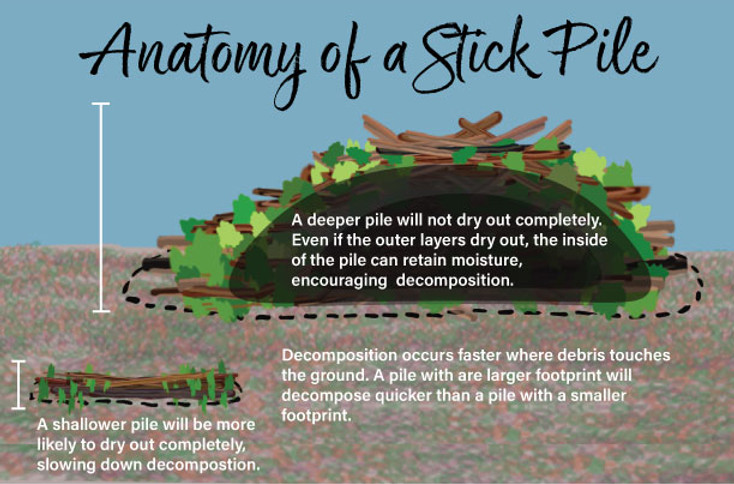
Treatment
How can the standard practices for reducing mulch be implemented in a forest setting?
What is the best way to manage mulch material generated from chipping invasive trees during restoration projects?
Palm logs are the ideal breeding material closely followed by wood of any tree species. If you can avoid chipping--chipping creates really great habitat for CRB and they can usually support higher numbers in a mulch pile compared to just a pile of whole material. If you do chip material, and you spread it pretty widely--so that it's barely covering the ground, it's not really going to be an accumulation of material that they like. The worst case scenario is to put chips in a big pile where it's all together. Spreading it out is better, and if you can spread it so thinly that it's almost a scattered--that could be a decent treatment as well.
What should I do with my existing slash piles? Is there a pesticide I can use, for example Citric Acid?
Chemical and pesticide treatments on mulch piles don't seem to work that well. We haven't tested Citric Acid, if you really soaked it, maybe. We've tested granular imidacloprid on four inches of mulch, and came back a couple months later and there was nice healthy CRB in there. So, I'm not sure of any effective chemicals for the breeding material. As far as the kinds of treatments that you can do, I think it depends on what's available to you. Burning is is a great tool. It's not legal in a lot of areas, and is a safety hazard. But where it's available, that's the best way to get rid of the waste because the ash is not infestable--CRB cannot breed in it so it reduces the amount of material available to CRB permanently. Smoke is probably a repellent as well. If you can't burn the material there's a number of things you can do if you've got an already infested pile. You can go through and collect by hand which is extremely labor intensive, but that does make a difference. You could send that material through a chipper or something and that would kill everything that's in there, but then you create that nice chipped material that can become infested later, so it's kind of a double edged sword. If you notice that something's already attractive to them, netting is probably the best medium effort that can be made. But judging how effective it's going to be depends on how much materials in the area, and how much you can put that netting on. If you net 1% of the breeding material in the area, you're going to reduce those beetle populations by less than 1%. The relative attractiveness likely plays into the efficacy of your treatment coverage--if you've got the most attractive pile, a greater proportion of the the beetles going to that site and therefore your treatment may be more effective.
What chemical applications are being tested for use in natural areas?
Most research on chemical applications is focused on palms, not specifically natural areas. Drone applications of pyrethrins/pyrethroids to crowns may be the best option especially in areas without good access to the base of every host plant. However, the impacts to the insect community should be considered for each site.
Can increasing the number of traps in natural areas reduce local CRB damage?
Traps catch an estimated 11% of CRB in an area. Trapping alone is usually not enough to see significant improvement in tree health but it can be part of an IMP strategy.
Is it better to net or tarp? (Tarps may be more easily available)
Tarp only masks scent, CRB can bore through tarps. Netting entangles CRB so netting is far better.
Can you pre-net a pile to prevent CRB from entering it, or is it only for preventing them from escaping.
Netting works in both directions, you can prophylactically net a pile.
What should we be doing to Pritchardia once they are deemed dead--from CRB damage or otherwise? Should we cut dead palms, or leave them standing?
Your management strategy will be informed by how active you can be at that site. If you have regular access, one strategy would be to leave that dead tree standing for a while until it becomes a breeding site and then chip it, so that you've killed everything. And then you would follow that up by netting your mulch pile. If you're going somewhere once a year, it's probably better just to cut down your dead tree, leave it in logs, and net it. For many, flying out dead Pritchardia material is not feasible. Which means that material has the opportunity to become both a sink and then a source for CRB. In these instances, cutting palms that have died from a CRB infestation makes it much easier for teams to survey and then detect more larval development. In some cases, you may choose to set up a pheromone lure to turn your netted breeding material into a trap. Depending on your resources and access, this may also provide an opportunity to gather more information about CRB during this unknown stage of their invasion.
What do you do with the stump once you've cut the palm down?
The palm was cut as close to soil level as possible. The trunk was then cut into three foot sections, and each section quartered. This material is all piled together and netting material was wrapped all over. The netting should be laid out as loose as possible--don't stretch it too tightly over your breeding material or it's going to be easier for the beetles to get through. If you give it a little bit of extra material, create some three dimensionality, it's harder for them to navigate and they are more likely to get entangled.
What diameter netting do you want to use?
There's a published paper on this that came out and from early guidance that we got from Guam, we recommend 1 inch stretched-hole size, or 1/2 inch x 1/2 inch grid. The way that a lot of gill netting is measured, and gill netting is usually what we buy, but it would apply to any netting, they measure it with a stretched hole size. If you took two adjacent knots and held them as tightly as you could, that's the stretched hole size. And then if you think about it as a grid, that's a half inch by half inch grid. That works really well for entangling a lot of CRB. Ideally, you would put netting in multiple layers, and when you put it in multiple layers, you can go with a larger mesh size, and they still get entangled. In the paper, they applied larger netting to palms and I assume it would be the same situation with mulch piles as well. Something to be aware of is that smaller sized gill nets are not legal to buy in Hawaii, because it's not legal to put in the oceans. Because most of the netting that's sold locally is for ocean use, you will have to use have a larger hole size if you want to purchase materials locally. In this case, multiple layers of larger sized netting will still work. It is legal to buy the recommended sized gill nets from an online or out-of-state vendor and then have it shipped here. According to EPA guidelines, if the netting is not sold as an insect control product, it is not regulated by FIRFA.
After netting, what actions can you take/do you need to take?
Ideally burning, chipping and removal, spreading thin etc.

click to enlarge
Predators
Do rats eat CRB?
It is not yet proven that rats eat CRB. We've seen mongoose, pigs, chicken and egrets eat CRB. But rats are a little more cryptic in their behavior and therefore harder to observe. However, it would make sense for rats to at least like larvae as a protein source.
Will wild pigs target and eat CRB larvae?
Domestic pigs will eat CRB larvae but it is unclear how desirable CRB are for wild pigs compared to other food available to them. Deep piles are harder to smell CRB and forage. Depending on the kind of predators that are in your area, if you're dealing with mongoose or pigs or something like that in your restoration areas, if you make it easy for them to find CRB, that's going to be helpful as well. Spreading piles thin can be a good approach when there are lots of predators.
Funding
What kind of funding opportunities are there to support CRB management in natural areas?
CRB response did receive some DLNR funds to help with, among other things, protection of Pritchardia populations. If you're interested, contact us [CRB Response Team] and we can talk about the site and what is possible and see if that's something that works out with our funding and staffing. It depends on where you are as well. The military has some REPI funds for climate preparedness and some of that can be used for CRB work as well. Most of the CRB Response funding from USDA does not apply to natural areas therefore most of what the CRB Response Team is doing is either on other islands for emergency response types of things, or at the airports. But we do have a little bit of money for specifically Pritchardia protection.
Other Questions
Besides moving collections of vulnerable species outside of Hawaiʻi, what other strategies can we implement to prevent the extinction of loulu on Oʻahu and Kauaʻi?
We know of a few other native species besides Pritchardia that are vulnerable to CRB. Are there others that should be tested?
I would recommend netting shorter loulu and particularly desirable or accessible larger plants. If populations plummet, chemical treatments may be warranted. Reducing propagule pressure from nearby areas is also a good idea. There are a lot of possible options for this but a green waste sanitation buffer is my first thought.
Mike Melzer at UH Mānoa has tested dozens in conjunction with ANRPO and DLNR. If you have concern over a specific species, reach out to Mike.
Additional Resources
Below, you will find additional CRB information. Click within the black borders to be redirected to the CRB Response website, the Statewide Communication Plan for CRB, or learn more about the inaugural CRB Science Syposium--with links to the agenda and youtube videos with presentations and discussions from both days.


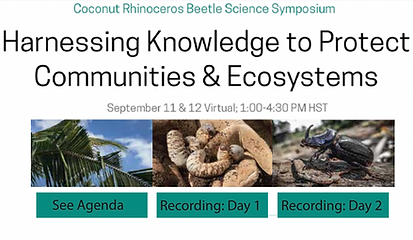
Brought to you by CRB Response, Pacific-RISCC and the Big Island Invasive Species Committee (BIISC)